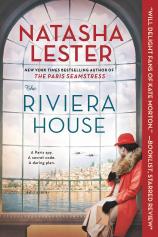Reading Group Guide
Discussion Questions
The Riviera House

1. Before reading the book, did you know about the theft of artworks from Jewish families in Paris by the Nazis during WWII? Had you heard of Rose Valland and her role as art savior? Why do you think the story of these paintings, and that of their protector Rose Valland, is a less well-known aspect of wartime history? Did reading THE RIVIERA HOUSE make you want to find out more about Rose?
2. Éliane asks her brother if, after the war, they will be judged by others and whether “instead of saving paintings, we should be saving people.” What do you think? Were the paintings worth the danger of spying on the Germans? Should her efforts and Rose’s efforts have been focused on rescuing people rather than rescuing artworks? What is the value of a piece of art?
3. In the Author’s Note at the end of the book, Natasha Lester explains that Rose Valland came by Göring’s Catalogue sometime after 1944, kept it a secret, and that the catalogue was only discovered after her death. Why do you think Rose didn’t share the catalogue more widely? Should she have? What might have impelled her to keep it a secret?
4. Like Natasha Lester’s other books, THE RIVIERA HOUSE mixes real people and real events with fictitious people and fictional events. What do you think of this approach to writing historical fiction? Is it wrong to create a narrative around Rose Valland and then change some of the events and insert people into those events who didn’t exist? Or can this way of telling a story bring the events of the past to life and ensure these events and people reach a wider audience so that more people can learn from and about history?
5. One of the themes of the book is about what makes a culture --- is it the people, the language, the artworks, the buildings, the collective spirit --- and whether war can destroy a culture or make it stronger. “So many things worth preserving have been ruined,” Xavier says to Éliane at one point. Why does war ruin some people and bring out the best in others? What parts of your culture are worth preserving, and would you fight to protect them?
6. In the contemporary narrative, did you enjoy visiting the towns of Saint-Jean-Cap-Ferrat and Èze? Which elements of this narrative were your favorite? Being introduced to the photography of Lousie Dahl-Wolfe? Remy and Adam’s love story? Remy’s journey through grief and to a new way of understanding both herself and her past? Something else?
7. Remy’s home on the French Riviera is based on the Villa Ephrussi de Rothschild in Saint-Jean-Cap-Ferrat. Google some pictures of the house, and discuss how the two houses are similar and different. Did reading about the house bring it to life in the same way as the pictures do? Does it look how you imagined it might?
8. Matt and Adam have a complicated relationship. Is Adam always understanding of his brother’s pain, or does Adam inflame the situation? Or is Matt solely to blame for their conflict? When could both of the brothers have behaved differently toward each other and thus improved their relationship?
9. Should Elke have done more to help Éliane and to actively work against her husband --- or was Elke in an impossible situation? Most especially, do you think Elke could have done something toward the end of the book to ensure the baby stayed with Éliane? Or would that have placed the baby in too much danger?
The Riviera House
- Publication Date: August 31, 2021
- Genres: Fiction, Historical Fiction
- Paperback: 480 pages
- Publisher: Forever
- ISBN-10: 153871731X
- ISBN-13: 9781538717318







